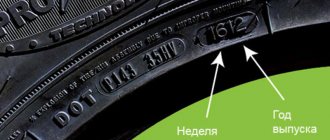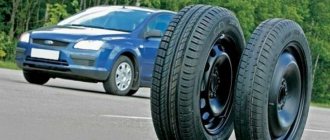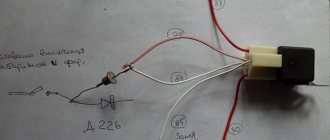Many drivers will have their own opinion on this matter. Some will be guided by legal requirements, namely the minimum tread depth. Others will say that tires should not be used for more than five years, after which the rubber loses its properties and becomes “wooden.” Still others will remember that they read about mileage restrictions, ranging from 40 to 60 thousand kilometers. Still others will operate only with the amount of money in their wallet.
There is, of course, a very desperate group of motorists. These guys ride until the last minute and wear down those meaty tires into racing slicks. Well, individual adherents can be seen rustling spikes on the asphalt in mid-July.
How do you like the rear tires of this Mitsubishi Galant?
Whose approach is correct? There is no clear answer, except that the latter pose a serious danger both to themselves and to other road users. Almost all the remaining methods have a certain logic behind them.
Shelf life of unused tires
It is a fact! If an unused tire is stored in a dry, dark room at a temperature of +15 to +25 C (they are also stored in BlackTyres), then according to GOST standards it will be considered new for 5 years from the date of production and will not age for 3 years.
This happens thanks to additives (anti-aging agents) that are added to the rubber mixture by the manufacturer itself. If you follow all the principles of proper storage, they will retain the beneficial properties of car tires for a long time. After tire installation, the internal pressure will begin to erode the anti-aging agents and begin the process of counting its “age”.
You can understand that a tire has begun to age prematurely by the following signs:
- Significant deformation of the sidewalls;
- Microcracks;
- Gray color with a white coating.
It is better not to buy a bloated gray tire with cracks in the tread. This is unlikely to be a new design, most likely it was simply stored incorrectly for a long time.
Shelf life of winter tires
These tires are made of special winter rubber to be more elastic and not crack in the cold. Because of this, they have a specific shelf life. If the temperature, humidity, and darkness are at the proper level, wheels (both with studs and tires without them) can be stored for up to 7 years without use.
Shelf life of summer tires
The summer tread is tougher in rubber composition than its winter counterparts. Its savings period is much longer than that of winter, but it cannot exceed 10 years in compliance with all possible rules.
Shelf life of all-season tires
All-season vehicles are popular among drivers living in warm climates with mild winters. If the conditions of lighting, humidity and temperature are not violated, the shelf life of these car tires is at least 5 seasons from the date of manufacture.
Recommendations for using summer tires
Summer tires are made from harder rubber, so they last longer. Nevertheless, compliance with a number of rules will ensure the durability of the rubber. Regular vehicle inspection often indicates this problem with the car.
It is important to independently inspect your tires monthly for changes (cracks, bumps, cuts, foreign objects), especially after impacts or sudden movements. Check the integrity of the disks and wheel alignment systems after impacts. Monthly monitoring of the pressure inside the wheels will eliminate many problems. If necessary, it is brought back to normal. Don't forget about:
- wheel balancing after 20 thousand km. mileage;
- lubricating rubber with moisturizing care products that protect against cracks;
- compliance with storage rules.
When purchasing used tires, you need to take into account possible non-compliance with the rules of operation and storage, as well as restoration, which reduces the safety of using tires. Therefore, they are used only for a short period of time, and then replaced with new ones. Following these rules will extend the life of your tires and make driving safe and comfortable.
The number of seasons that summer tires can withstand is also influenced by factors beyond the driver’s control (weather conditions, road quality). Also his personal responsibility and accuracy (compliance with the speed limit, timely inspection of the vehicle, care and storage of tires).
Tire life
It is a fact!
Once the new tire is on the car's wheels, you can drive it without fear of tread wear for an average of another 5 years. However, the five-year service period is only a convention. What is much more important is not the release date, but the degree of everyday wear and mileage of the tire. It is worth paying attention to the remaining tread depth: for passenger cars weighing less than 3.5 tons it is 1.6 mm, for trucks over 3.5 tons - 1.0 mm, for buses - 2.0 mm, for motorcycles and mopeds - 0.8 mm.
The service life of car tires will begin to steadily decline for several reasons:
- Excessively high tire pressure and high overloads;
- Daily mileage;
- Car suspension malfunctions;
- Aggressive driving (will last 1-2 seasons);
- Driving on bad roads.
However, even with the most careful driving, the maximum service life is 10 years. According to the manufacturers, having crossed this threshold, the tire will lose all its useful properties due to a high degree of wear, and driving with such a tread will become simply dangerous.
The maximum mileage after which it is recommended to change the tire also matters. Its value depends on the type of transport:
- Passenger cars with a carrying capacity of up to 2 tons – 45 thousand km.
- Trucks 2-4 tons - 60 thousand km.
- Trucks over 4 tons – 68-70 thousand km.
Beware - a myth! They say that car tires of different batches have different service periods and wear resistance, which means the production date can also cause a defect even with low mileage. But the truth is that the composition of raw materials and technology are the same for everyone, and it doesn’t matter where in the world the industry leader opened his next plant. The operational requirements are the same both in Germany and in Taiwan.
Service life of winter tires
When the car does get new “shoes”, it is worth considering that the service life of winter tires differs depending on the type of winter tires:
- Friction (“Velcro”) will last up to five seasons if driven carefully and without extreme wear.
- Studded tires will last an average of 3-4 seasons, again if their driver does not want to regularly check the tread for strength during steep turns and off-road conditions.
Lifespan of summer tires
Summer treads are created more rigid than elastic and soft winter ones, and therefore the service life of tires with the most careful driving of a car on a flat road surface is on average 5-6 years.
Service life of all-season tires
The wear rates of car tires greatly depend on the climate in which the trips take place, but when driving in European winters and hot summers, all-season tires “live” on average 3-4 years.
Mileage
Another guideline for changing tires is mileage. You can often find recommendations on the Internet that refer to GOST. Their text reads: for passenger cars with a carrying capacity of up to two tons, the tire service life is 45,000 kilometers.
You can also find references to the operational mileage standards for vehicle tires approved by the Ministry of Transport of the Russian Federation. Their average service life varies from 40 thousand kilometers for Russian tires to 60 thousand for foreign ones. Please note that this document lost force after the entry into force of the Technical Regulations of the Customs Union.
You can also determine how long a tire can run using the Treadwear (TW) parameter, which indicates the tire wear resistance index. It is not often paid attention to. This figure is usually of interest to those who plan to use the car in a sports environment. Soft and, accordingly, grippy rubber has a fairly low TW, which is what racers focus on.
Surely you have a reasonable question about how the wear resistance index relates to mileage. TW appeared thanks to specialists from the National Highway Traffic Safety Administration (NHTSA). To calculate it, the tire at the test site is compared with a special sample, the TW of which is already known.
According to the methodology, TW100 is equivalent to 48 thousand kilometers until the rubber is completely worn out, that is, Nokian Hakka Green, for example, having TW400, can last up to 192 thousand kilometers. True, in the real world, wear is influenced by many factors that we discussed above, as well as driving style. Therefore, it is recommended to divide the calculation results for TW by two. It turns out 96 thousand, or almost 5 years of operation, provided that in the warm season the car travels about 20 thousand kilometers.
Incorrect tire pressure can significantly reduce tire life. Don't forget to check it
In total, we have three parameters that should help you understand how long tires will last if used correctly, and also tell you when to send a set of tires for scrap and bother buying new ones. This can be done on the Kolesa.kz portal using the search form in the “Spare parts” section.
From theory to practice
Enough has already been said in theory about what the service life and shelf life of tires are. Now let's talk about whether it's worth bothering yourself with these numbers when going to the store. Lately, the issue that tires need to be checked almost like milk cartons has been raised more and more often and only confuses buyers.
The first thing to keep in mind: in the warehouse of a large online store (including BlackTyres) tires are in constant circulation. It is extremely difficult to sort them depending on the service period due to the fact that storekeepers ship thousands of items every day, and order delivery points accept mixed batches. There are very rare cases when they will be determined by year - usually in the off-season, or when a large batch has arrived from the factory, but they will be stored in common cells.
Second: we have tires in our warehouse that are 4-5 years old after manufacture. They are sold along with the “young ones”, since people often drive older models, change them 1-2 times a year and do not complain. However, if the client is concerned about the expiration date, he will be given a letter of guarantee that we take responsibility for the occurrence of warranty cases.
And finally, the last and most important: in all modern enterprises, tires are produced mainly by robots on high-precision equipment using the same technology, with the same composition of raw materials. Therefore, there is no difference between products that were released three years apart, if the storage rules were not violated.
Methods for determining tire wear
It is important to periodically check the condition of your tires and whether they are safe to drive. This is the only way to prevent the cost of paying off car fines, as well as to prevent a serious accident.
How do you know if the tires are still safe to drive?
First way . Checking the wear indicator.
The indicator is a tread block that is located in the recesses of the tread. The height of the indicator determines the wear rate (1.6–4 mm). When the tread has worn down to the indicator, the tires can no longer be driven.
To find the indicator, carefully inspect the side of the tire. Opposite the tread block you will find a mark in the shape of a triangle, the manufacturer’s logo, a snowflake or the abbreviation TWI.
On modern tires you can see digital indicators. Numbers are applied to the tread indicating the level of recess. When tires wear out, the numbers disappear: first the largest value disappears, then the smallest one, indicating the maximum tread wear depth. How long can you drive on summer tires if all the numbers except 2 and 4 have been erased? This suggests that the tires should be changed as soon as possible. As soon as the number 2 is erased, the tire will become completely worn out; it is undesirable to allow such a situation.
Second way . We use a measuring device.
You can purchase a special device to determine the tread profile depth. The cost of the meter is small, as are its dimensions. With its help, you can determine how badly the tires have worn out by checking them in 2-3 places.
We recommend
“Interchangeable tire sizes: look in the table, calculate it yourself” Read more
The third method . Measuring with a coin.
Can't use the indicator to determine how much longer you can drive on your tires? Is it not possible to use a measuring device? Just take a coin worth 10 kopecks. From the edge where the word “kopeck” is located, we insert a coin into the tread groove.
You should not see the inscription “kopecks”. Otherwise, you can no longer ride on the tires.
Tire marking
This is complete information about tires in one place. It is standard; dimensions, technological characteristics, and features are indicated on the side.
What to look for when purchasing
When purchasing, you need to look at the following characteristics:
- Is the type and size suitable for a particular car? These specs look like 195/65R15, where:
- 195 – profile width in millimeters;
- 65 – percentage ratio of profile height and width;
- R – radial cord;
- 15 – disk diameter in inches.
You can learn about the needs of a specific machine from technical documents.
- Speed and load. For example, 98W means: 98 – load per wheel (kg). W – maximum speed (km/h). Decodings are indicated in special tables common to the whole world.
- Brand, date of manufacture. After the manufacturer's letter designation there are four numbers - this is the week and year of manufacture.
- Seasonality. The summer one is marked with the image of the sun, the winter one – with snowflakes.
How to identify expired tires
You need to find the production date and add 5 years to it. You also need to stock up on measuring instruments and assess the degree of tread wear. The residual height of 2-3 mm will be critical for summer, and 4-6 mm for winter.
When tires should not be used
For your own safety, it is better not to use:
- Tires that have served their service life for 5 years. This is especially true for winter tires and cases where the conditions for storing and caring for them are unknown.
- Operation beyond the permissible tread wear is prohibited.
- With uneven wear.
The law does not oblige car owners to change tires; this is a matter of personal responsibility to themselves and other areas of the road.
Source
Storage period for tires for cars without use
According to GOST, it is 5 years, but this does not mean that they will be unsuitable.
What is more important here is how they were stored all this time. When changing from summer to winter or vice versa, an unused set must be kept in appropriate conditions so that it will last for more than one season.
Storage conditions
If tires are stored without rims, they are placed on the tread. If on disks, they need to be hung or stacked on top of each other. To maintain elasticity, you will need to lubricate with a special tire care product.
Where is better
A warehouse without a source of direct sunlight, exposure to ozone, or mineral oils is ideal for this purpose. It should be well heated (from +10 to +35 °C), and the humidity should be maintained at a normal level (











